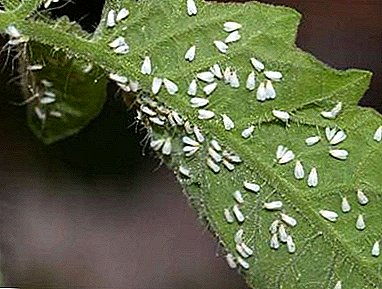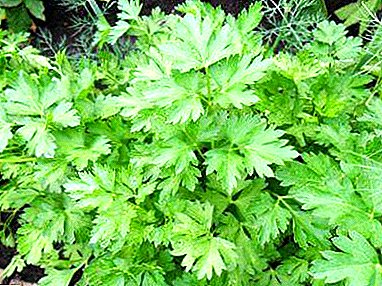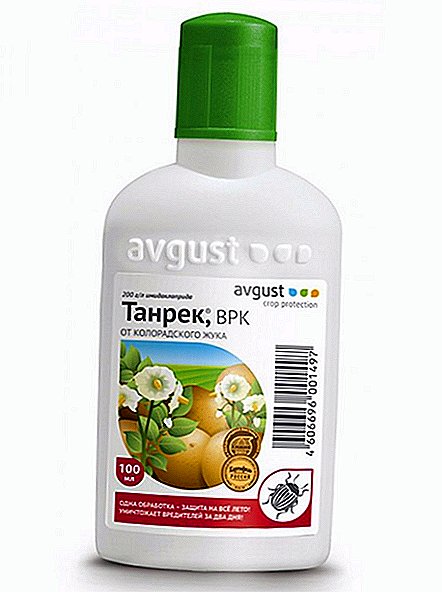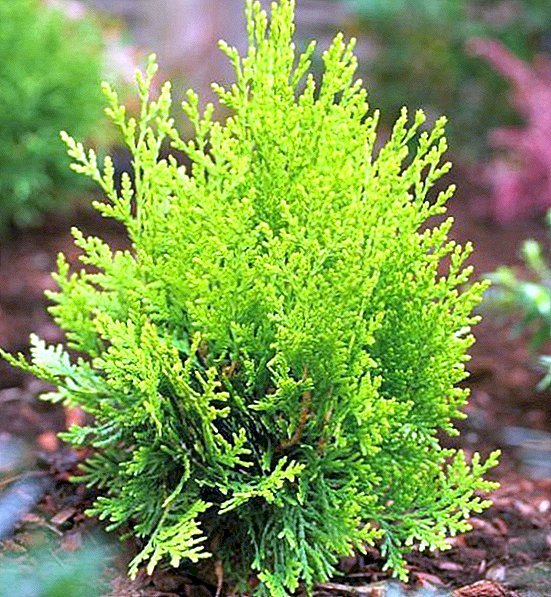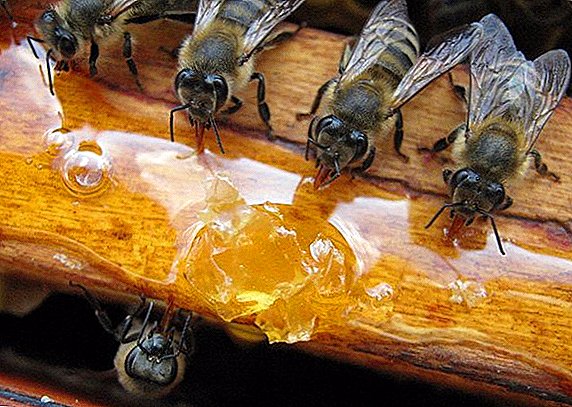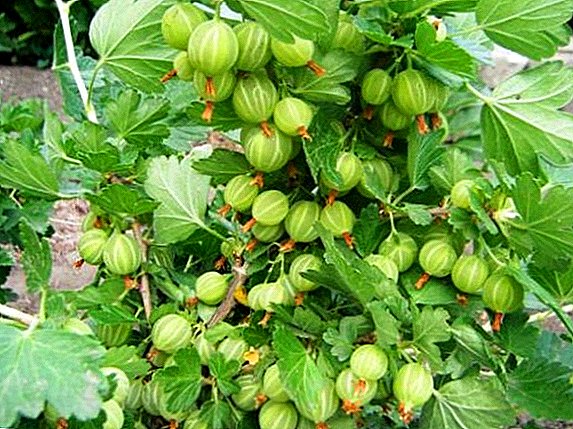 Among the home plants can often be found Calathea. It belongs to the family maranty and has about 130 species. In nature, the plant is found in South and Central America, and its name means "basket" - from the leaves of Calathea once wove a basket.
Among the home plants can often be found Calathea. It belongs to the family maranty and has about 130 species. In nature, the plant is found in South and Central America, and its name means "basket" - from the leaves of Calathea once wove a basket.
Today, calathea is grown for ornamental purposes. Her colorful leaves look unusual and serve as an interior decoration. The leaves of the plant are large, can reach 30 cm in length, are oval, elliptical, elongated, grow from the rosette. They always turn to the sun. Some species are capable of flowering, and their flowers are collected in dense inflorescences of various colors.
Did you know? In addition to the beautiful leaves, Calathea has another feature. In the evening, the leaves rise up and the lower part of the leaf becomes visible. If you watch this process day after day, it seems that the leaves of the plant are moving. Because of this, the plant is also called the prayer flower.
In room conditions, they are most adapted for growing Kalathea, decorated with Calathea, Calatheum Makoya, striped, and Veitch Calathea. Not all flower growers can afford to get a calathea, this is due to the great capriciousness of the plant. On the nuances of caring for Calathey, we will continue.
Optimum conditions for keeping Calathea in the house
 Indoor Kalatea flower requires a lot of attention. This is a tropical plant, so he likes the heat and light. You should also pay attention to watering and take care of suitable soil.
Indoor Kalatea flower requires a lot of attention. This is a tropical plant, so he likes the heat and light. You should also pay attention to watering and take care of suitable soil.
Location and lighting
To satisfy the need for light and warmth of a calathe, you need to find a suitable place for her in the house. It tolerates the shadow normally, but it will not develop in absolute shadow, let alone blossom. If a calathea is in the dark for a long time, the decorative color of its leaves becomes just green, the patterns go away. With a lack of light, Calathea grows more slowly. Therefore, it should be placed in lighted areas. At the same time direct sunlight should be avoided, as they can leave burns on the leaves. It is best to grow a plant on or near the western and eastern windows.
Important! Calathea does not like permutations, sudden changes in temperature and drafts.
Temperature conditions
Caring for a calathea at home also means ensuring a comfortable temperature regime for it. The plant does not tolerate cold, the temperature below 16 degrees is destructive for him. The optimum temperature range is -16-23 ° C.
Sudden temperature drops are fraught with the death of Calathea. Cold drafts also have a detrimental effect - the leaves become sluggish and rot.
Comprehensive care for calathea at home
 Homes for Calathea should create conditions similar to the tropical jungle microclimate. The penumbra suits her, as in nature she grows under the shade of tall trees, while receiving a sufficient amount of light. The temperature in tropical forests does not fall below 18 degrees, and there are no sudden changes in temperature. Calathea can absorb moisture on the leaf surface, so high humidity conditions are good for it.
Homes for Calathea should create conditions similar to the tropical jungle microclimate. The penumbra suits her, as in nature she grows under the shade of tall trees, while receiving a sufficient amount of light. The temperature in tropical forests does not fall below 18 degrees, and there are no sudden changes in temperature. Calathea can absorb moisture on the leaf surface, so high humidity conditions are good for it.
Recreating the jungle microclimate at home is not so easy, but you can get as close as possible to it. It is necessary to take care of sufficient watering, ensuring the humidity of the air and feeding the plant.
What should be watering Calathe
Watering Calathea should be sufficient, especially in summer. The water should be soft, suitable rainwater and melting snow. You can artificially soften water with peat, for which a few handfuls of it are put in a fabric bag and dipped in a container with water overnight. In the morning the water will be suitable for watering Calathe.
Care must be taken that the roots do not start to deteriorate from excess moisture. In summer, watering is more abundant, by winter it should be gradually reduced.
Air humidity
 To create a favorable microclimate for Calathea, a humidifier is useful. In the absence of such, you can do with simple means at hand. For example, put claydite in a plant tray and fill it with water. A pot with a plant placed on expanded clay should not come into contact with water. You can use pebbles, wet sand, sphagnum moss instead of expanded clay.
To create a favorable microclimate for Calathea, a humidifier is useful. In the absence of such, you can do with simple means at hand. For example, put claydite in a plant tray and fill it with water. A pot with a plant placed on expanded clay should not come into contact with water. You can use pebbles, wet sand, sphagnum moss instead of expanded clay.
Since the plant needs high air humidity, a natural question arises: can calathea be sprayed. Spraying the leaves themselves is strongly discouraged, this is especially important for species with velvety soft leaves. For species with smooth leaves, it is better if they are sometimes just wiped with a damp cloth. You can periodically spray the air around the plant with the help of a small spray gun, avoiding contact with it.
As an option, a calathea with a pot can be settled in an empty terrarium, at the bottom of which you can put moss, sand or expanded clay. The material at the bottom of the terrarium should be wet, in which case a specific microclimate will be created without moisture drops and drafts.
Fertilizer and fertilizer Calathea
 Calatheum needs to be fed with fertilizers. But remember that the plant reacts poorly to both the deficiency and the excess fertilizer - the ends of the leaves become yellow-brown in color. Feeding can be done every two weeks during the period of active growth, which falls in March-September. In the fall and winter, calathean fertilizers are applied once every six weeks.
Calatheum needs to be fed with fertilizers. But remember that the plant reacts poorly to both the deficiency and the excess fertilizer - the ends of the leaves become yellow-brown in color. Feeding can be done every two weeks during the period of active growth, which falls in March-September. In the fall and winter, calathean fertilizers are applied once every six weeks.
Species that bloom, it is worth feeding fertilizer for flowering plants.
Proper transplantation and composition of soil mixture
It is customary to perform a calathea transplant about once every two years, and young plants under the age of four years each year. If necessary, replant the grown plant. A transplant of a calathea, only brought into a new home, can be carried out after a week-long adaptation of the plant in new conditions.
Important! In the process of vital activity, Calathea secretes substances into the soil, which after some time may begin to harm it. Therefore, it is necessary to transplant the plant in a fresh substrate in a timely manner.
 The optimal time for a calathea transplant is the beginning of spring. The pot for the plant should be chosen shallow and wide, as the roots grow horizontally under the soil. In a fairly wide pot, underground shoots form short vertical shoots with rosettes. Thus, the plant grows, gives offspring. For transplanting take the dishes 2 cm more than the previous one.
The optimal time for a calathea transplant is the beginning of spring. The pot for the plant should be chosen shallow and wide, as the roots grow horizontally under the soil. In a fairly wide pot, underground shoots form short vertical shoots with rosettes. Thus, the plant grows, gives offspring. For transplanting take the dishes 2 cm more than the previous one.
At the bottom of the tank put a drainage, which is used as expanded clay. The land for calathea is prepared from leaf and humus soil, peat and sand. All components are taken in one piece, and sand - half. You can also use ready-made soil for rhododendrons, maranth or azaleas, in which you can add a little charcoal and sand.
Before planting in the new soil, the roots of the plant should be cleaned from the old substrate. For a pest-afflicted or diseased plant, this is especially important. The rotten roots found at the same time need to be cut off, and the cuts sprinkle with charcoal. Having placed a plant in a new soil, its roots need to be decomposed into a layer of soil on the drainage and sprinkled on them without tamping the soil.
Important! The thickening at its root found during transplantation of the calathea — stolons, bulbs — cannot be removed. These are natural formations in which the plant stores nutrients, moisture.
Breeding calathea
 When a plant looks thick, grows, has many hereditary shoots, the question becomes how to spread calathea at home. This process is best combined with transplant.
When a plant looks thick, grows, has many hereditary shoots, the question becomes how to spread calathea at home. This process is best combined with transplant.
Split plant is planted each in its own capacity and put in a warm place under the film. The film helps to recreate the greenhouse, in which the flower quickly takes root in the ground. At the same time it is necessary to maintain the usual temperature for the plant.
Pots for seating Calathea take a diameter of 10 cm. After rooting, it can be transplanted into pots of a larger diameter - 15 cm.
In the first independent year of life, the plant should be fed in the summer once a week, in the winter once every three weeks. The seeds of calathea are very difficult to propagate, as they rarely sprout.
Did you know? The most unpretentious are kalateya makoya and kalateya wonderful. The most fascinating species are zebrovid calathea and calathea redhead.
Pests and diseases Calathei, how to deal with them
 Calathea at home needs close attention. Any violations in the care may cause a change in the color of the plant, spots appear on it, the leaves wither and dry. In such situations, it is important to determine the cause and eliminate it.
Calathea at home needs close attention. Any violations in the care may cause a change in the color of the plant, spots appear on it, the leaves wither and dry. In such situations, it is important to determine the cause and eliminate it.
Important! Calathea feels bad if its leaves no longer rise in the evenings, if the tips of the leaves turn brown and spots appear on them.Pests on calathea appear in case of insufficient air humidity. Pests such as scale insects, thrips, spider mites affect it - the plants turn yellow and fall leaves.
To get rid of pests, the plant must be treated with soapy water. If the desired effect is not achieved, use an insecticide.
Another trouble that occurs when there is insufficient moisture is that the ends of the leaves dry on the calatheus. In this case, you need to put the plant pot on wet pebbles or use other methods of humidifying the air around the plant. The plant can also dry due to insufficient watering, drafts, and thrips damage.
 Spots on the leaves indicate sunburn. Yellow leaves can be both a natural sign and unfavorable. If the lower leaves turn yellow, this is normal, old ones die off and new ones appear. If the problem with the upper layers - an overdose of fertilizers, low temperature or improper watering.
Spots on the leaves indicate sunburn. Yellow leaves can be both a natural sign and unfavorable. If the lower leaves turn yellow, this is normal, old ones die off and new ones appear. If the problem with the upper layers - an overdose of fertilizers, low temperature or improper watering.
The leaves of the calathea curl from dry or cool air, drafts.
Important! When choosing a plant, you need to study its appearance and find out the name. Externally, the plant should be healthy, without stains and twisting on the leaves.
A plant can look good only if the florist provides him with ideal conditions. Therefore, if you are not ready to spend a lot of time for growing household plants, it is better to give up calathea and engage in less capricious plants.


